Infiltration Characteristics and Spatiotemporal Distribution of Soil Moisture in Layered Soil under Vertical Tube Irrigation
Abstract
1. Introduction
2. Materials and Methods
2.1. Field Experiments
2.2. Laboratory Experiments
2.3. Irrigation Water Productivity
3. Results
3.1. Field Experiment Results
3.1.1. Jujube Tree Yield and Water Productivity
3.1.2. Soil Moisture Distribution in the Field
3.2. Laboratory Experiment Results
3.2.1. Cumulative Infiltration
3.2.2. Wetted Body Changes with Time
3.2.3. Variation in Transport Distance of Wetting Front
3.2.4. Effect of Layer Interface on Water Infiltration
3.2.5. Variation in Soil Water Content
4. Discussion
4.1. Effects of Vertical Tube Irrigation on Jujube Yield and IWP
4.2. Infiltration Characteristics in Layered Soil with Vertical Tube in Laboratory
5. Conclusions
Author Contributions
Funding
Conflicts of Interest
References
- Patel, N.; Rajput, T.B.S. Effect of drip tape placement depth and irrigation level on yield of potato. Agric. Water Manag. 2007, 88, 209–223. [Google Scholar] [CrossRef]
- Patel, N.; Rajput, T.B.S. Dynamics and modeling of soil water under subsurface drip irrigated onion. Agric. Water Manag. 2008, 95, 1335–1349. [Google Scholar] [CrossRef]
- Abuarab, M.; Mostafa, E.; Ibrahim, M. Effect of air injection under subsurface drip irrigation on yield and water use efficiency of corn in a sandy clay loam soil. J. Adv. Res. 2013, 4, 493–499. [Google Scholar] [CrossRef] [PubMed]
- Mo, Y.; Li, G.; Wang, D. A sowing method for subsurface drip irrigation that increases the emergence rate, yield, and water use efficiency in spring corn. Agric. Water Manag. 2017, 179, 288–295. [Google Scholar] [CrossRef]
- Coltro, L.; Marton, L.F.M.; Pilecco, F.P.; Pilecco, A.C.; Mattei, L.F. Environmental profile of rice production in Southern Brazil: A comparison between irrigated and subsurface drip irrigated cropping systems. J. Clean. Prod. 2017, 153, 491–505. [Google Scholar] [CrossRef]
- Pendergast, L.; Bhattarai, S.P.; Midmore, D.J. Evaluation of aerated subsurface drip irrigation on yield, dry weight partitioning and water use efficiency of a broad-acre chickpea (Cicer arietinum, L.) in a vertosol. Agric. Water Manag. 2019, 217, 38–46. [Google Scholar] [CrossRef]
- Li, J.S.; Li, Y.F.; Zhang, H. Tomato Yield and Quality and Emitter Clogging as Affected by Chlorination Schemes of Drip Irrigation Systems Applying Sewage Effluent. J. Integr. Agric. 2012, 11, 1744–1754. [Google Scholar] [CrossRef]
- Martínez, J.; Reca, J. Water use efficiency of surface drip irrigation versus an alternative subsurface drip irrigation method. J. Irrig. Drain. Eng. 2014, 140, 1–9. [Google Scholar] [CrossRef]
- Jacques, D.; Fox, G.; White, P. Farm level economic analysis of subsurface drip irrigation in Ontario corn production. Agric. Water Manag. 2018, 203, 333–343. [Google Scholar] [CrossRef]
- Cai, Y.; Wu, P.; Zhang, L.; Zhu, D.; Chen, J.; Wu, S.J.; Zhao, X. Simulation of soil water movement under subsurface irrigation with porous ceramic emitter. Agric. Water Manag. 2017, 192, 244–256. [Google Scholar] [CrossRef]
- Zhu, J.; Jin, J.; Yang, C. Effects of trace quantity irrigation on yield, dry matter portioning and water use efficiency of spherical fennel grown in greenhouse. Paiguan Jixie Gongcheng Xuebao/J. Drain. Irrig. Mach. Eng. 2014, 32, 338–342. [Google Scholar]
- Song, P.; Li, Y.; Zhou, B.; Zhou, C.; Zhang, Z.; Li, J. Controlling mechanism of chlorination on emitter bio-clogging for drip irrigation using reclaimed water. Agric. Water Manag. 2017, 184, 36–45. [Google Scholar] [CrossRef]
- Zhou, H.; Li, Y.; Wang, Y.; Zhou, B.; Bhattarai, R. Composite fouling of drip emitters applying surface water with high sand concentration: Dynamic variation and formation mechanism. Agric. Water Manag. 2019, 215, 25–43. [Google Scholar] [CrossRef]
- Das Gupta, A.; Babel, M.S.; Ashrafi, S. Effect of soil texture on the emission characteristics of porous clay pipe for subsurface irrigation. Irrig. Sci. 2009, 27, 201–208. [Google Scholar] [CrossRef]
- Kandelous, M.M.; Šimůnek, J. Comparison of numerical, analytical, and empirical models to estimate wetting patterns for surface and subsurface drip irrigation. Irrig. Sci. 2010, 28, 435–444. [Google Scholar] [CrossRef]
- Yao, W.W.; Ma, X.Y.; Li, J.; Parkes, M. Simulation of point source wetting pattern of subsurface drip irrigation. Irrig. Sci. 2011, 29, 331–339. [Google Scholar] [CrossRef]
- Ren, C.; Zhao, Y.; Wang, J.; Bai, D.; Zhao, X.; Tian, J. Lateral hydraulic performance of subsurface drip irrigation based on spatial variability of soil: Simulation. Agric. Water Manag. 2017, 193, 232–239. [Google Scholar] [CrossRef]
- Bai, D.; He, J.; Guo, L.; Wang, L. Infiltration characteristics of vertical tube subirrigation as affected by various factors. Trans. Chin. Soc. Agric. Eng. 2016, 32, 101–105. [Google Scholar]
- Bai, D.; Sun, S.; Ren, P.; Xu, X. Temporal and spatial variation of wetting volume under sub-irrigation with vertical emitter. Trans. Chin. Soc. Agric. Eng. 2018, 34, 107–113. [Google Scholar]
- Mohammadzadeh-Habili, J.; Heidarpour, M. Application of the Green-Ampt model for infiltration into layered soils. J. Hydrol. 2015, 527, 824–832. [Google Scholar] [CrossRef]
- Soulis, K.X.; Elmaloglou, S. Optimum soil water content sensors placement for surface drip irrigation scheduling in layered soils. Comput. Electron. Agric. 2018, 152, 1–8. [Google Scholar] [CrossRef]
- Cho, K.W.; Song, K.G.; Cho, J.W.; Kim, T.G.; Ahn, K.H. Removal of nitrogen by a layered soil infiltration system during intermittent storm events. Chemosphere 2009, 76, 690–696. [Google Scholar] [CrossRef] [PubMed]
- Cui, G.; Zhu, J. Prediction of unsaturated flow and water backfill during infiltration in layered soils. J. Hydrol. 2018, 557, 509–521. [Google Scholar] [CrossRef]
- Ma, Y.; Feng, S.; Su, D.; Gao, G.; Huo, Z. Modeling water infiltration in a large layered soil column with a modified Green-Ampt model and HYDRUS-1D. Comput. Electron. Agric. 2010, 71, 40–47. [Google Scholar] [CrossRef]
- Deng, P.; Zhu, J. Analysis of effective Green-Ampt hydraulic parameters for vertically layered soils. J. Hydrol. 2016, 538, 705–712. [Google Scholar] [CrossRef]
- Li, J.S.; Ji, H.Y.; Bei, L.I.; Liu, Y.C. Wetting Patterns and Nitrate Distributions in Layered-Textural Soils Under Drip Irrigation. Agric. Sci. China 2007, 6, 970–980. [Google Scholar] [CrossRef]
- van Genuchten, M.T. A closed form equation for predicting the hydraulic conductivityof unsaturated soils. Soil Sci. Soc. Am. J. 1980, 44, 892–898. [Google Scholar] [CrossRef]
- van Genuchten, M.; Leij, F.J.; Yates, S.R. The RETC Code for Quantifying the Hydraulic Functions Unsaturated Soils; EPA/600/2-91/065; R.S. Kerr Environmental Research Laboratory, U.S. Environmental Protection Agency: Okla, LA, USA, 1991. [Google Scholar]
- Monaco, F.; Sali, G. How water amounts and management options drive Irrigation Water Productivity of rice. A multivariate analysis based on field experiment data. Agric. Water Manag. 2018, 195, 47–57. [Google Scholar] [CrossRef]
- Dai, Z.; Fei, L.; Huang, D.; Zeng, J.; Chen, L.; Cai, Y. Coupling effects of irrigation and nitrogen levels on yield, water and nitrogen use efficiency of surge-root irrigated jujube in a semiarid region. Agric. Water Manag. 2019, 213, 146–154. [Google Scholar] [CrossRef]
- Li, Y.; Ren, X.; Hill, R.; Malone, R.; Zhao, Y. Characteristics of Water Infiltration in Layered Water-Repellent Soils. Pedosphere 2018, 28, 775–792. [Google Scholar] [CrossRef]
- Huang, M.; Barbour, S.L.; Elshorbagy, A.; Zettl, J.; Si, B.C. Effects of Variably Layered Coarse Textured Soils on Plant Available Water and Forest Productivity. Procedia Environ. Sci. 2013, 19, 148–157. [Google Scholar] [CrossRef]
- Allaire, S.E.; Dadfar, H.; Denault, J.T.; van Bochove, E.; Charles, A.; Thériault, G. Development of a method for estimating the likelihood of finger flow and lateral flow in canadian agricultural landscapes. J. Hydrol. 2011, 403, 261–277. [Google Scholar] [CrossRef]
- Rawls, W.J.; Gish, T.J.; Brakensiek, D.L. Estimating soil water retention from soil physical properties and characteristics. Adv. Soil Sci. 1991, 16, 213234. [Google Scholar]
- Ma, L.; Wang, X.; Gao, Z.; Wang, Y.; Nie, Z.; Liu, X. Canopy pruning as a strategy for saving water in a dry land jujube plantation in a loess hilly region of China. Agric. Water Manag. 2019, 216, 436–443. [Google Scholar] [CrossRef]
- Yang, H.; Rahardjo, H.; Leong, E.C. Behavior of unsaturated layered soil columns during infiltration. J. Hydrol. Eng. 2006, 11, 329–337. [Google Scholar] [CrossRef]
- Wang, J.; Niu, W.; Li, Y.; Lv, W. Subsurface drip irrigation enhances soil nitrogen and phosphorus metabolism in tomato root zones and promotes tomato growth. Appl. Soil Ecol. 2018, 124, 240–251. [Google Scholar] [CrossRef]
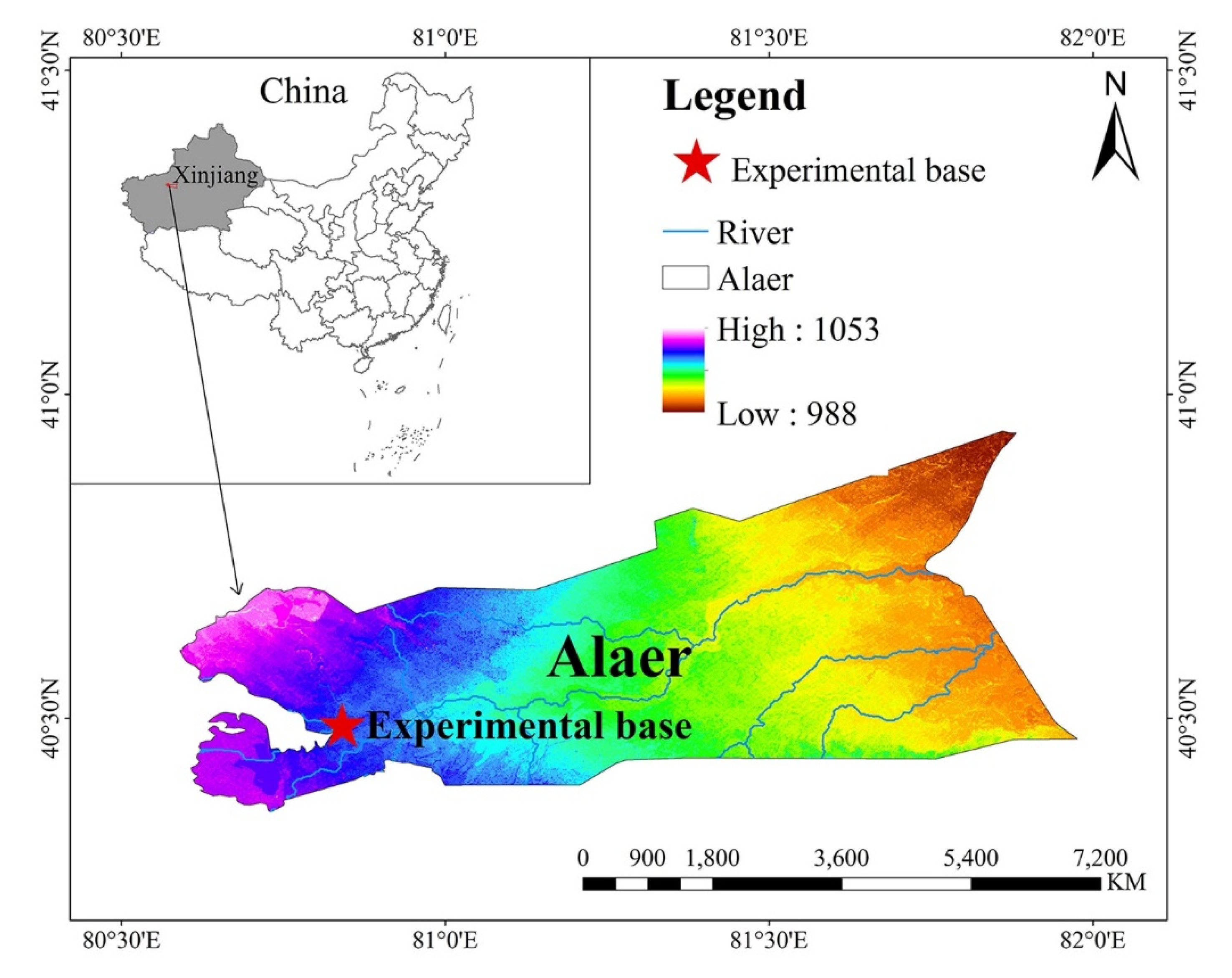
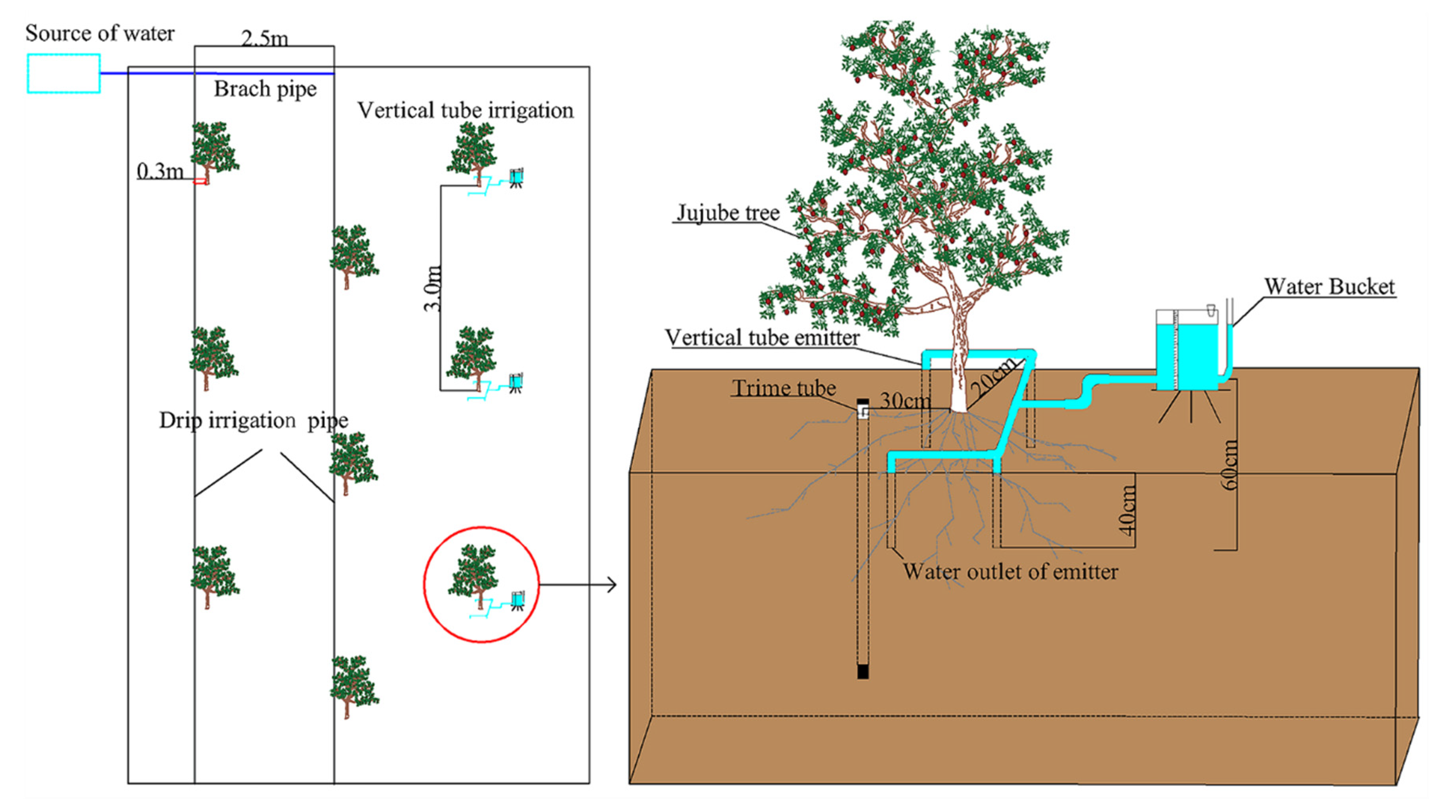
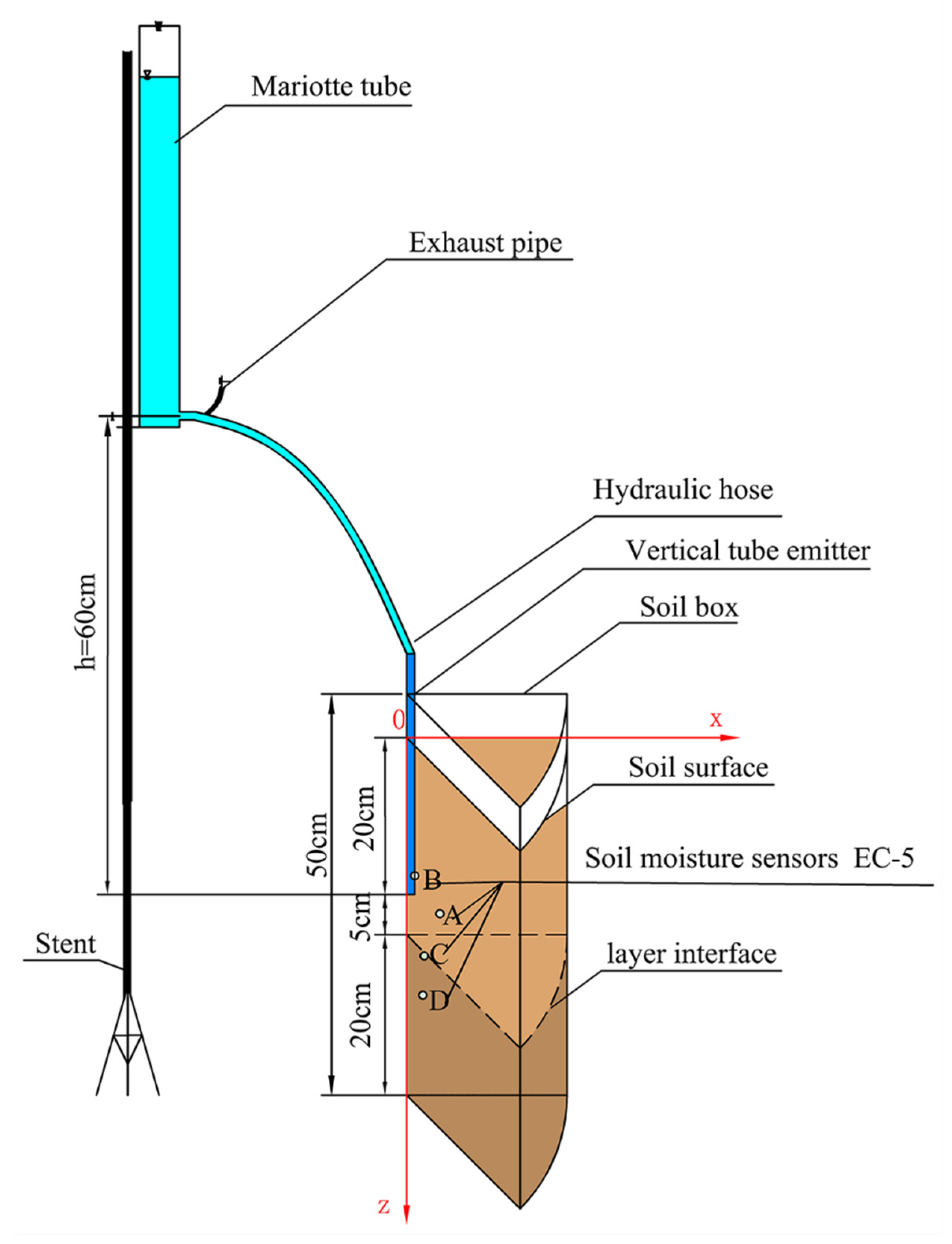
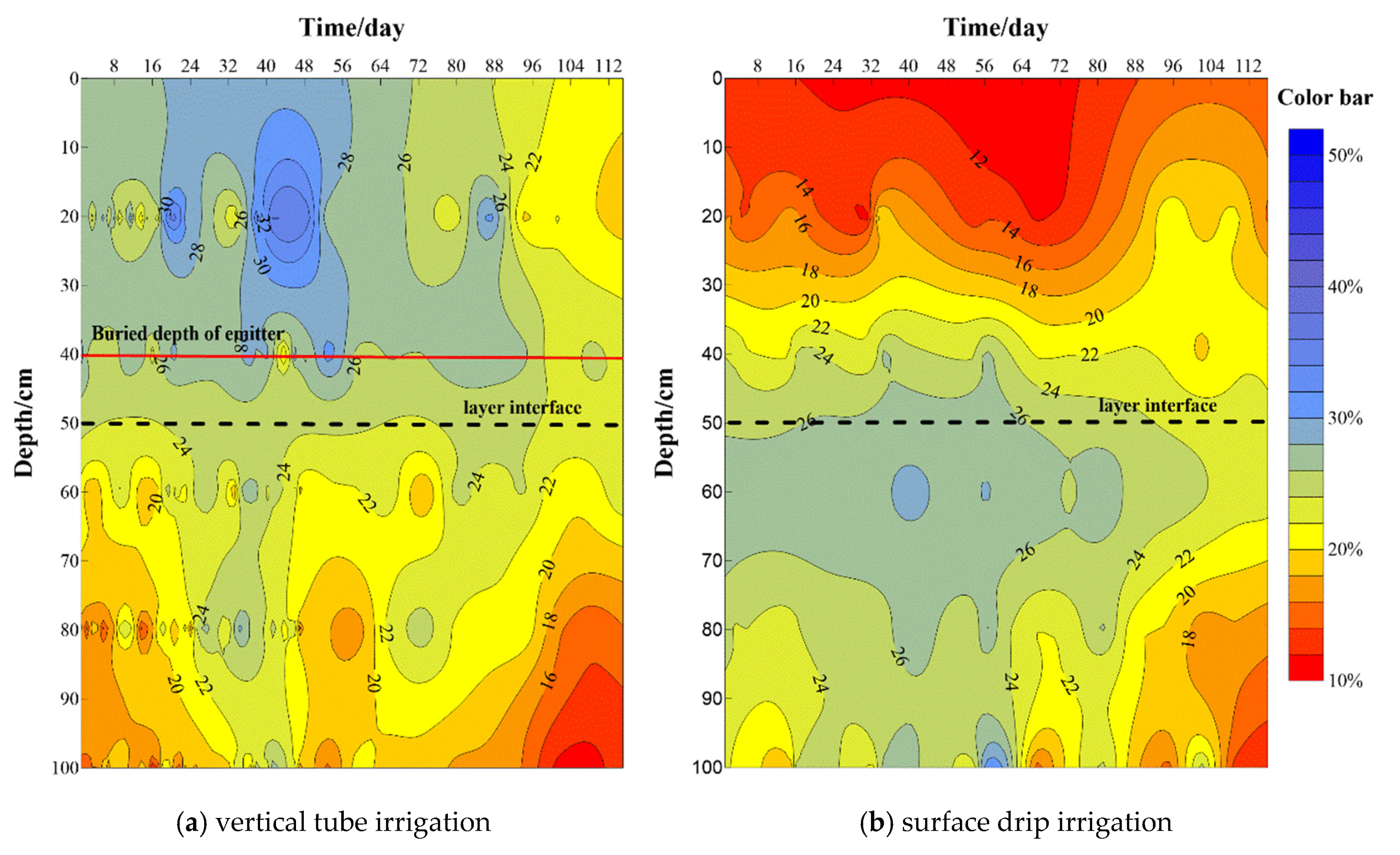

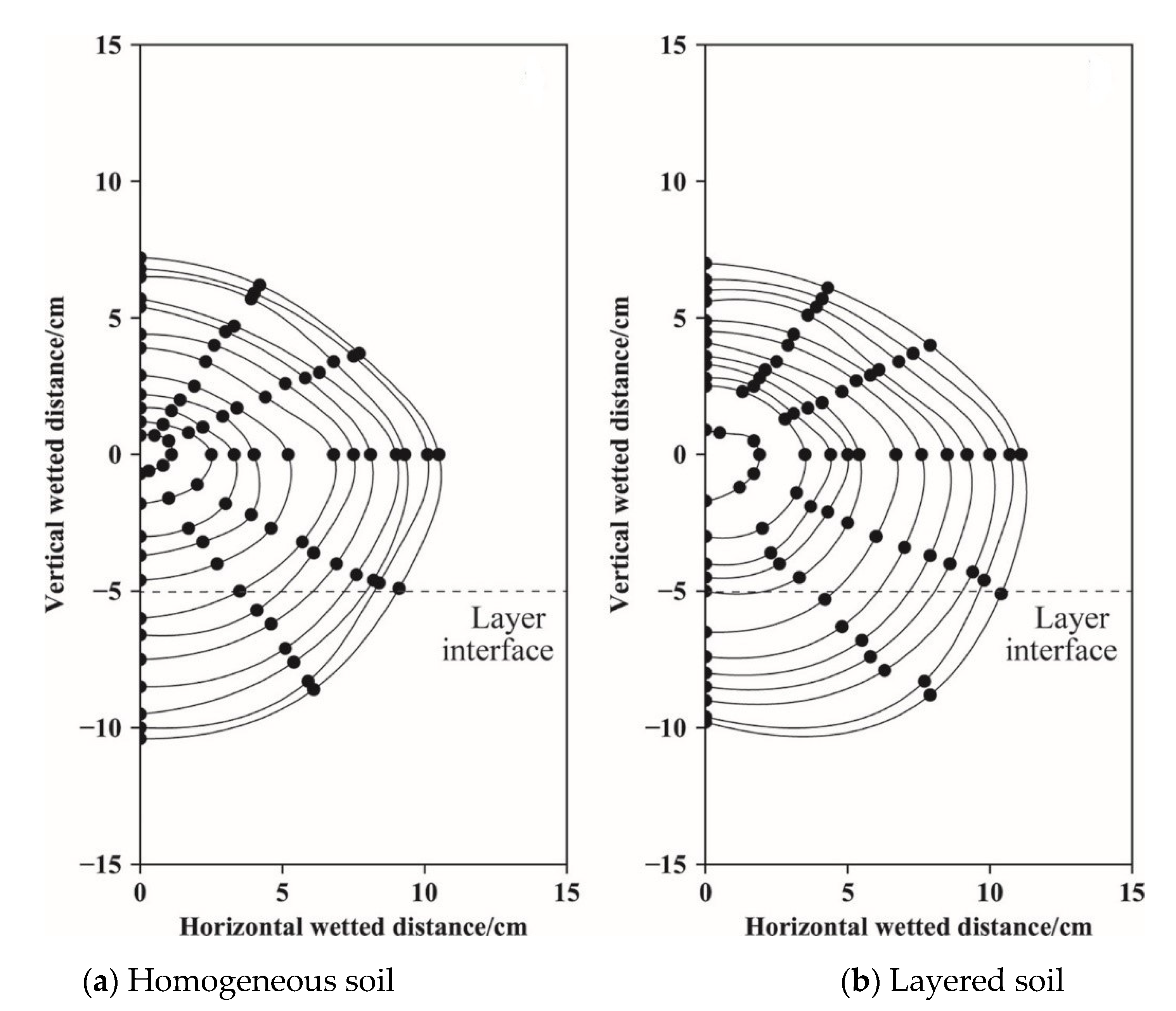
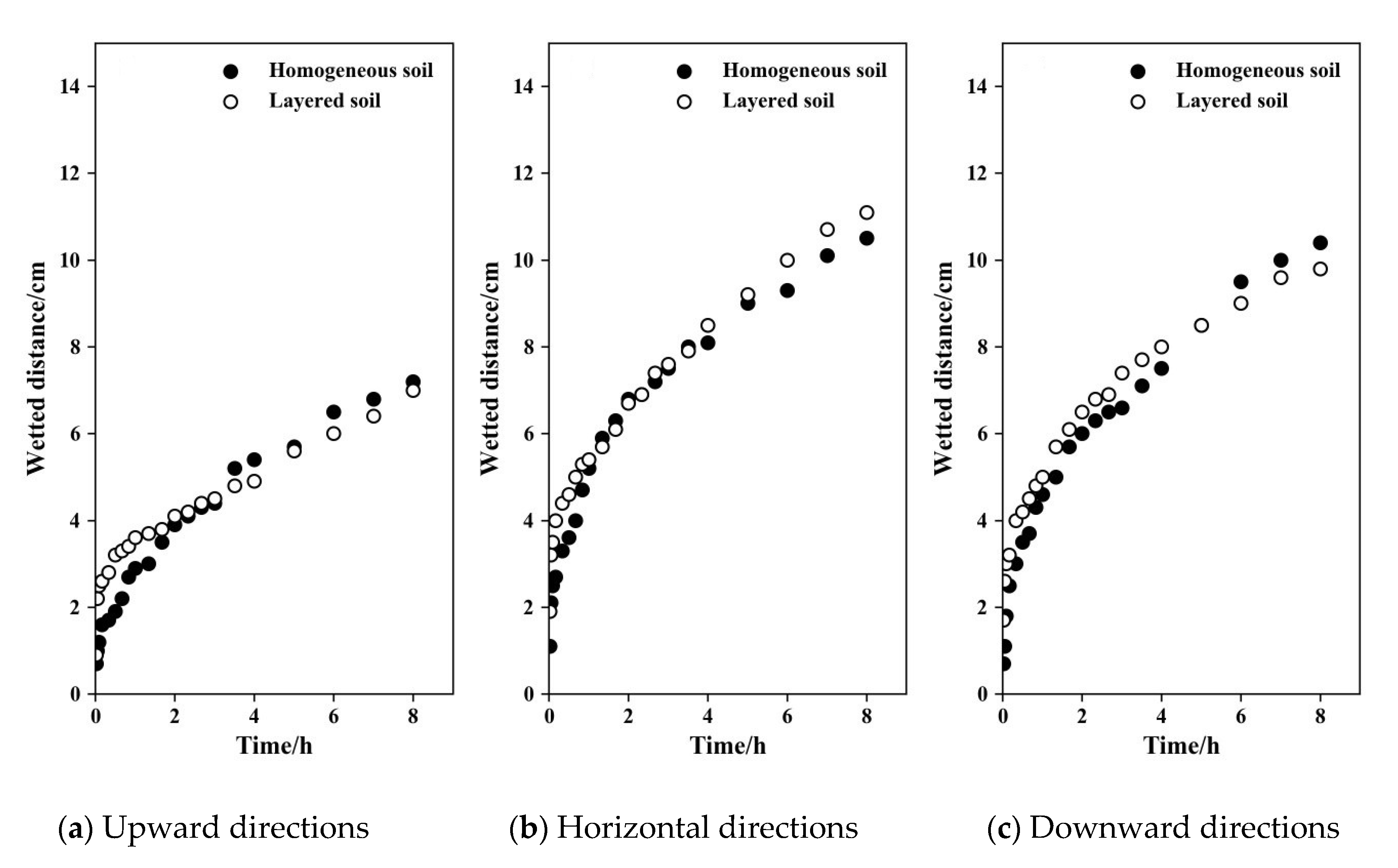
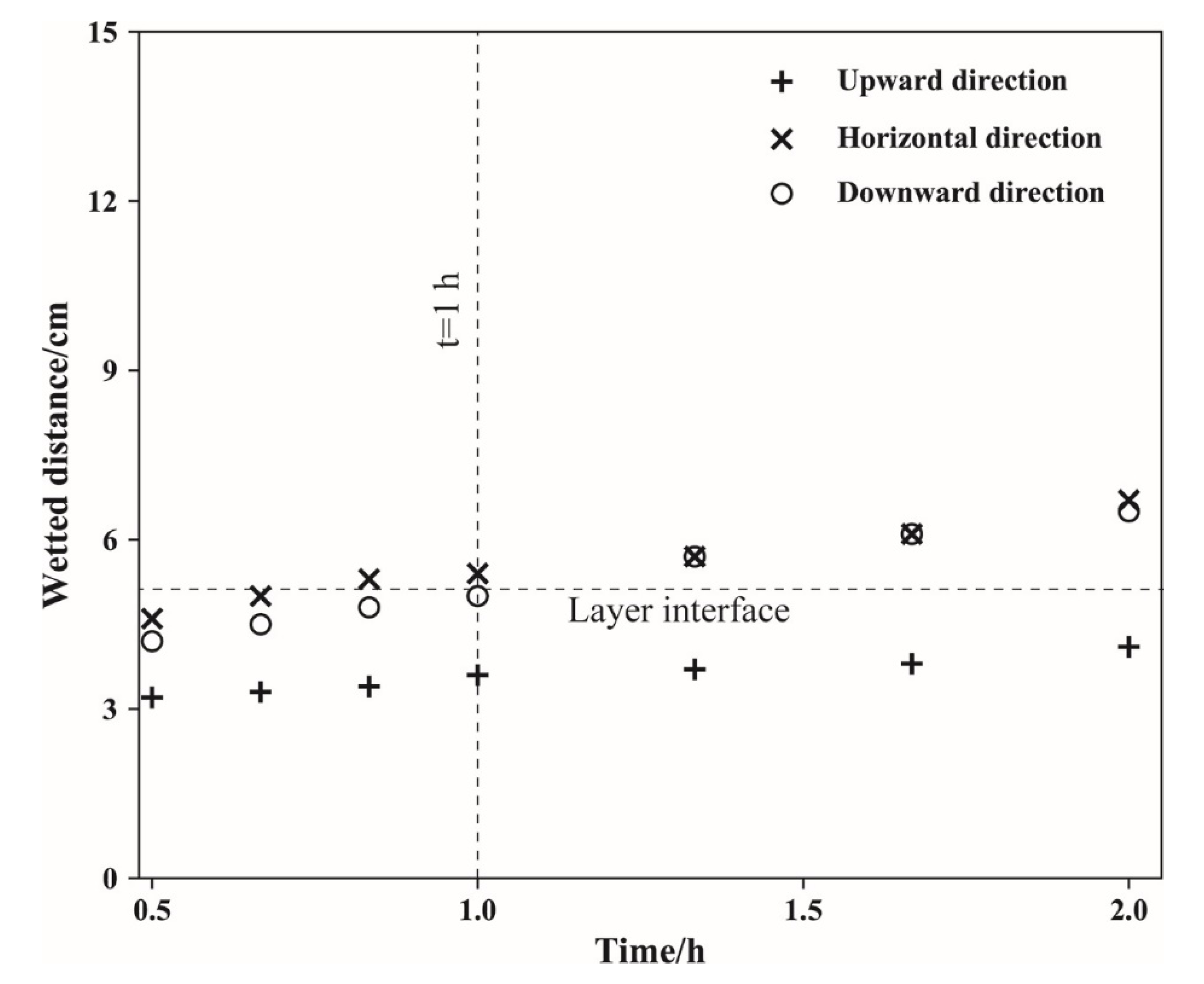
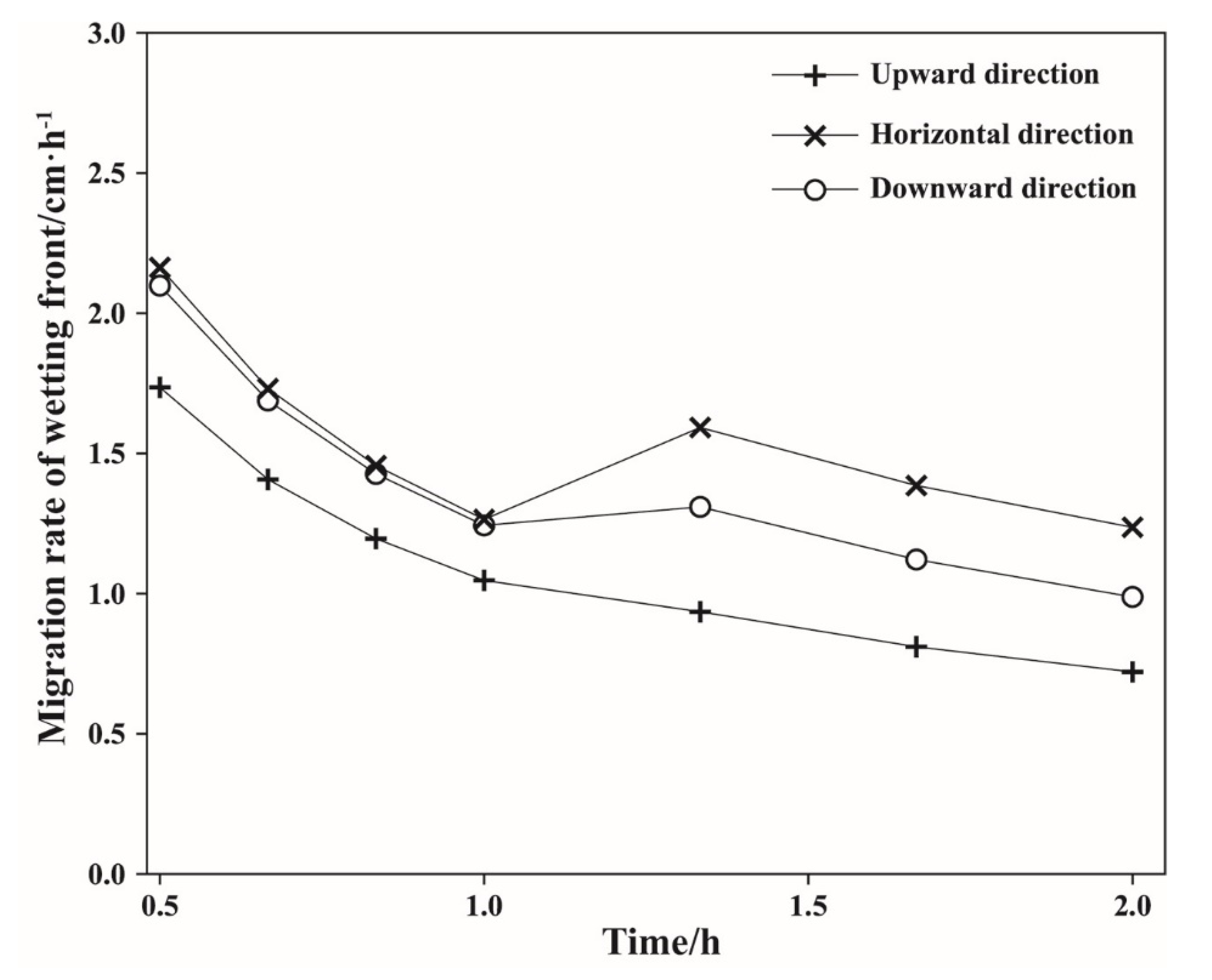
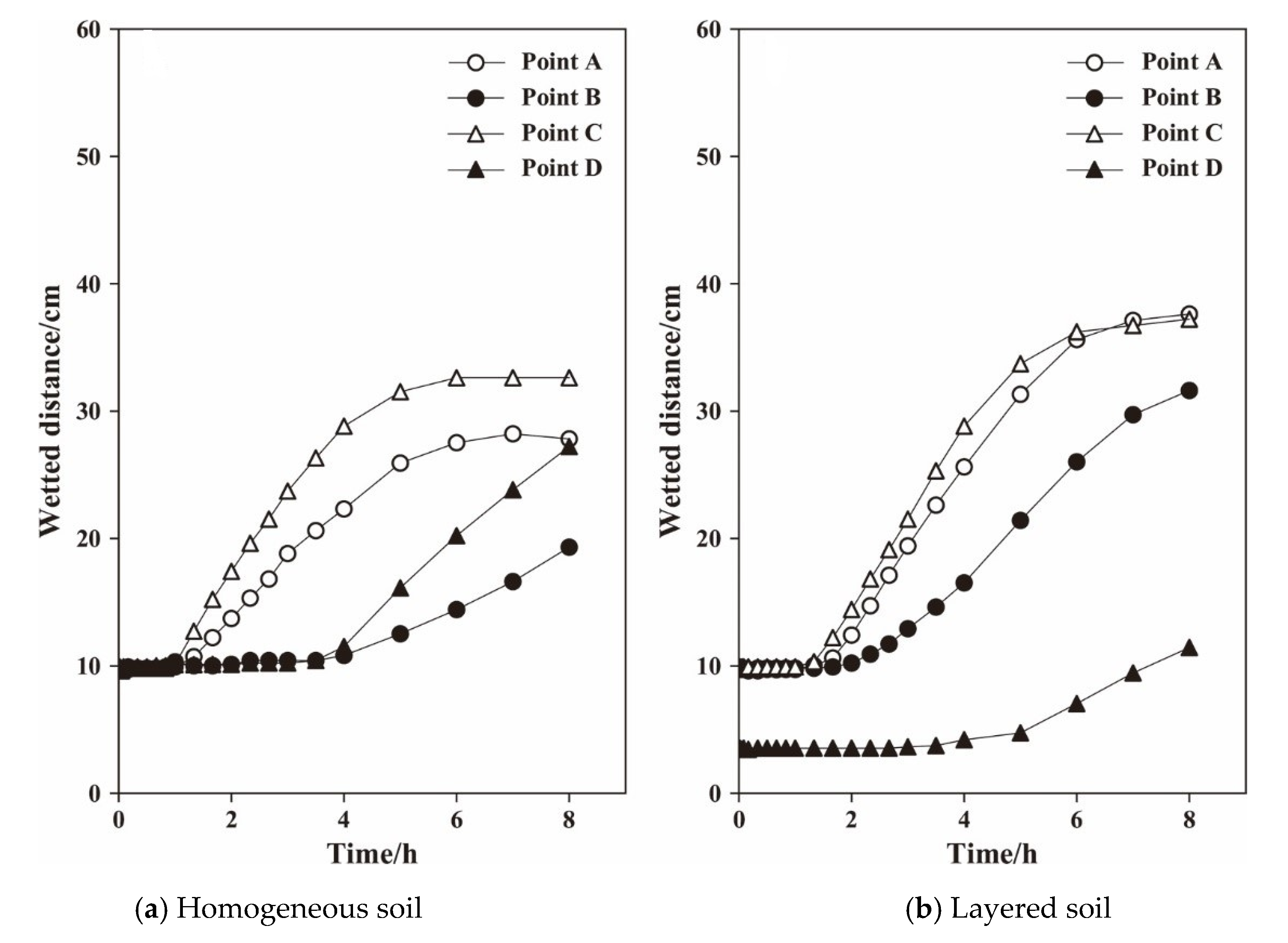
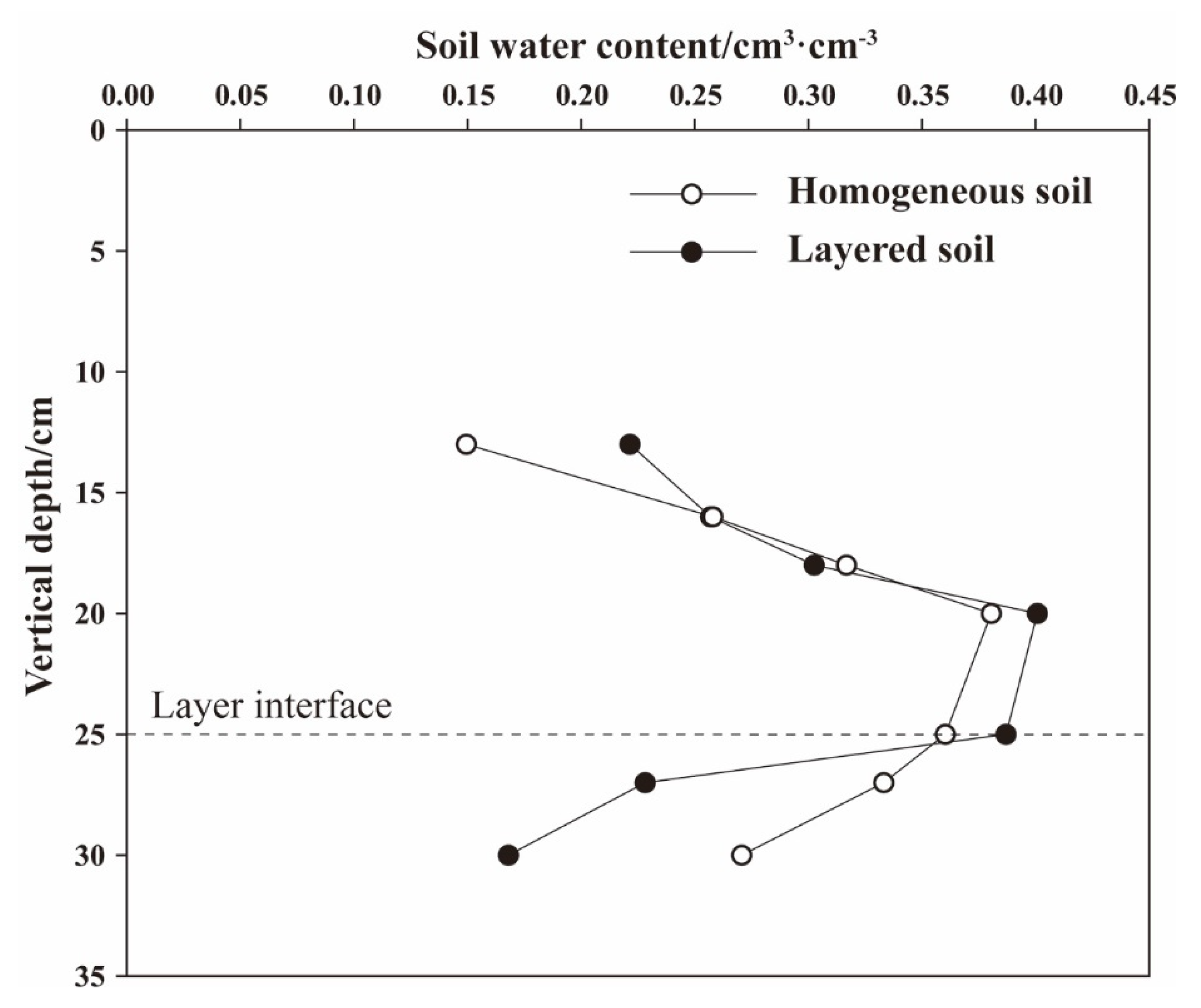
| Content/% | Soil Texture b | ρ/g·cm−3 | θi/cm3·cm−3 | θs/cm3·cm−3 | |||
|---|---|---|---|---|---|---|---|
| Clay | Silt | Sand | |||||
| <0.002 a | 0.002–0.2 | 2–0.2 | |||||
| Field | 6.64 | 47.71 | 45.64 | Silty loam | 1.44 | 0.223 | 0.446 |
| 3.95 | 28.5 | 67.55 | Sandy loam | 1.47 | 0.221 | 0.437 | |
| Laboratory | 6.78 | 47.01 | 46.21 | Silty loam | 1.44 | 0.098 | 0.419 |
| 5.57 | 30.85 | 63.58 | Sandy loam | 1.47 | 0.047 | 0.367 | |
| Soil Texture | n | m | Ks/cm·min−1 | ||
|---|---|---|---|---|---|
| Silty loam | 0.0357 | 0.0129 | 1.4874 | 0.3277 | 0.0234 |
| Sandy loam | 0.0476 | 0.0359 | 3.4067 | 0.7065 | 0.5356 |
| Depth/cm | Homogeneous Soil | Layered Soil |
|---|---|---|
| 0–25 | Silty loam | Silty loam |
| 25–45 | Sandy loam |
| Irrigation Method | Experiments Number | I/mm | Y/ Mg·ha−1 | IWP/kg·m−3 |
|---|---|---|---|---|
| Vertical tube irrigation | 1 | 154 | 15.80 | 6.16 |
| 2 | 254 | 14.36 | 3.39 | |
| 3 | 214 | 14.87 | 4.17 | |
| * | 207 ± 41b | 15.01 ± 0.60 | 4.57 ± 0.12a | |
| Surface drip irrigation | 1 | 489 | 14.70 | 2.76 |
| 2 | 483 | 15.10 | 3.02 | |
| 3 | 495 | 15.47 | 2.69 | |
| * | 489 ± 5a | 15.09 ± 0.31 | 2.82 ± 0.14b |
Publisher’s Note: MDPI stays neutral with regard to jurisdictional claims in published maps and institutional affiliations. |
© 2020 by the authors. Licensee MDPI, Basel, Switzerland. This article is an open access article distributed under the terms and conditions of the Creative Commons Attribution (CC BY) license (http://creativecommons.org/licenses/by/4.0/).
Share and Cite
Wang, C.; Bai, D.; Li, Y.; Wang, X.; Pei, Z.; Dong, Z. Infiltration Characteristics and Spatiotemporal Distribution of Soil Moisture in Layered Soil under Vertical Tube Irrigation. Water 2020, 12, 2725. https://doi.org/10.3390/w12102725
Wang C, Bai D, Li Y, Wang X, Pei Z, Dong Z. Infiltration Characteristics and Spatiotemporal Distribution of Soil Moisture in Layered Soil under Vertical Tube Irrigation. Water. 2020; 12(10):2725. https://doi.org/10.3390/w12102725
Chicago/Turabian StyleWang, Cheng, Dan Bai, Yibo Li, Xinduan Wang, Zhen Pei, and Zuochao Dong. 2020. "Infiltration Characteristics and Spatiotemporal Distribution of Soil Moisture in Layered Soil under Vertical Tube Irrigation" Water 12, no. 10: 2725. https://doi.org/10.3390/w12102725
APA StyleWang, C., Bai, D., Li, Y., Wang, X., Pei, Z., & Dong, Z. (2020). Infiltration Characteristics and Spatiotemporal Distribution of Soil Moisture in Layered Soil under Vertical Tube Irrigation. Water, 12(10), 2725. https://doi.org/10.3390/w12102725




